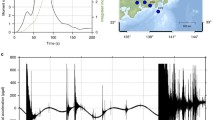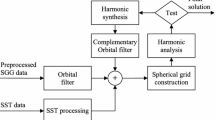Abstract
We used high-pass filtering and the Fourier transform to analyze tidal gravity data prior to five earthquakes from four superconducting gravity stations around the world. A stable gravitational perturbation signal is received within a few days before the earthquakes. The gravitational perturbation signal before the Wenchuan earthquake on May 12, 2008 has main frequency of 0.1–0.3 Hz, and the other four have frequency bands of 0.12−0.17 Hz and 0.06−0.085 Hz. For earthquakes in continental and oceanic plate fault zones, gravity anomalies often appear on the superconducting gravimeters away from the epicenter, whereas the stations near the epicenter record small or no anomalies. The results suggest that this kind of gravitational perturbation signals correlate with earthquake occurrence, making them potentially useful earthquake predictors. The far-field effect of the gravitational perturbation signals may reveal the interaction mechanisms of the Earth’s tectonic plates. However, owing to the uneven distribution of gravity tide stations, the results need to be further confirmed in the future.
Similar content being viewed by others
References
Aster, R. C., McNamara, D. E., and Bromirski, P. D., 2008, Multidecadal climate-induced variability in microseisms: Seismol. Res. Lett., 79(2), 194–202.
Chen, Y. T., 2007, Earthquake prediction progress, difficulties and prospect: Seismological and Geomagnetic Obsevation and Research (in Chinese), 28(2), 1–24.
Geller, R. J., Jackson, D. D., Kagan, Y. Y., and Mulargia, F., 1997, Earthquakes cannot be predicted: Science, 275, 1616–1617.
Hao, J. G., Pan, H. W., Mao, G. M., Zhang, Y. F., Tang, T. M., Li, R. D., and Li, S., 2000, Anomaly of quasi-static electric field and earthquake-exploration of a reliable earthquake precusor: Seismological and geomagnetic observation and research, 21(4), 3–166.
Hao, X. G., and Hu, X. G., 2008, Disturbance before the Wenchuan earthquake detected by broadband seismometer: Progress in Geophysics (in Chinese), 23(4), 1332–1335.
Hao, X. G., and Hu, X. G., 2011, Discussion on strategic thinking for short-term prediction of great earthquakes: Progress in Geophys (in Chinese), 26(2), 456–461.
Hao, X. G., Hu, X. G., Xu, H. Z., et al., 2008, gravity disturbance before wenchuan Ms8.0 earthquake: Journal of Geodesy and Geodynamics, 3, 129–131.
Hao, X. G., Xu, H. Z., Hao, X. H., Lv, C. C., and Hu, H. Q., 2001, Gravity high-frequency disturbanceand occurrence of earthquake: Crustal Deformation and Earthquake, 21(3), 9–13.
Hu, X. G., and Hao, X. G., 2009, Observation of foreseismic disturbance of the 2009/03/19 Mw7.6 Tonga earthquake: Progress in Geophys, 24(2), 866–870.
Hu, X. G., Hao, X. G., and Xu, X. X., 2010, The analysis of the non-typhoon-induced microseisms before the 2008 Wenchuan earthquake: Chinese J. Geophys.(in Chinese), 53(12), 2875–2886.
Ihmle, P. F., and Jordan, T. H., 1994, Teleseismic search for low precursors to large earthquake: Science, 266, 1547–1551.
Jiang, H. K., Ma, S. L., Zhang, L., Hou, H. F., and Cao, W. H., 2002, Spatio-temporal characteristics of acoustic emission during the deformation of rock samples with compressional and extensional en-echelon fault pattern: Acta Seism-ologica Sinica, 24(4), 385–396.
Kanamori, H., and Cipar, J. J., 1974, Focal process of the great chilean earthquake May 22, 1960: Physics of the Earth and Planetary Interiors, 9, 128–136.
Kato, A., Obara, K., Igarashi, T., Tsuruoka, H., Nakagawa, S., and Hirata, N., 2012, Propagation of slow slip leading up to the 2011 Ms9.0 Tohoku-Oki earthquake: Science, 335(6069), 705–708.
Kizawa, T., 1972, Recording of gravimeter around strong carthquake: Oversea Earthquakes, 1, 39–41.
Kranz, R. L., and Scholz, C. H., 1977, Critical dilatant volume of rocks at the onset of tertiary creep: Journal of Geophysical Research, 82(30), 4893–4898.
Lan, S. C., Yu, T. T., Hwang, C., and Kao, R., 2011, An analysis of mechanical constraints when using superconducting gravimeters for far-field preseismic anomaly detection: Terr. Atmos. Ocean. Sci., 22(3), 271–282.
Liu, C. C., Linde, A. T., and Sacks, I. S., 2009, Slow earthq uakes triggered by typhoons: Nature, 459, 833–836.
Liu, L. Q., Ma, S. L., Ma, J., et al., 1999, Effect of rock structure on statistical characteristics of acoustic emission: Earthquake Research in China, 13(3), 355–366.
Longuest-Higgins, M. S., 1950, A theory of microseisms:.Philos. Trans. R. Soc. London, Ser. A, 243, 1–35.
Mei, S. R., Feng, D. Y., Zhang, G. M., Zhu, Y. Q., Gao, X., and Zhang, Z. C., 1993, Introduction to earthquake prediction in China: Seismological Press (in Chinese), BeiJing, 96–126.
Mogi, K., 1962a, On the time distribution of aftershocks accompanying the recent maior earthquakes in and near Japan: Bull. Earthquake Res. Inst., 49, 107–124.
Mogi, K., 1962b, Study of elastic shocks caused by the fracture of heterogeneous materials and its relations to earthquake phenomena: Bull. Earthquake Res. Inst., 49, 125–173.
Mogi, K., 1963, Some discussion of aftershocks, foreshocks, and earthquake swarms—the fracture of a semidnfinite body caused by an inner stress origin and its relation to earthquake phenomena, 3rd paper: Bull. Earthquake Res. Inst., 41, 615–618.
Mogi, K., 1967, Effect of the intermediate principal stress on rock failure: J. Geophys Res., 72, 5117–5131.
Obert, L., 1939, Measurement of pressures on rock pillars in underground mines, part I: US Bur: Mines RI, 3444, 1940–1950.
Obert, L., and Duvall, W., 1945, Microseismic method of predicting rock failure in underground mining, Part I. General method: Bureau of Mines, Washington, DC(USA).
Peng. J., Rong, G., Zhou, C. B., Wang, X. J., and Hou, D., 2013, Experimental study of effect of water pressure on progressive failure process of rocks under compression: Rock and Soil Mechanics, 34(4), 941–946.
Qi, G. Z., 1978, Dilatancy-magnetic effect: Chinese Journal of Geophysics (inchinese), 21(1), 18–33.
Qiu, Y. H., Liu, C. S., and Dai, Q. W., 2008, Natural electric field method for prediction of earthquake: Central South University Press (in Chinese), Changsha, 16–137.
Scholz, C. H., 1968, The frequency-magnitude relation of microfracturing in rock and its relation to earthquakes: Bulletin of the Seismological Society of America, 58(1), 399–415.
Shen, W. B., Wang, D. J., and Huang, J. W., 2011, Anomalous signals prior to Wenchuan earthquake detected by superconducting gravimeter and broadband seismometers records: J. Earth Sci., 22(5), 640–651.
Tanimoto, T., 2007a, Excitation of normal modes by nonlinear interaction of ocean waves: Geophys. J. Int., 168, 571–582.
Tanimoto, T., 2007b, Excitation of microseisms: Geophys. Res. Lett., 34, L05308, doi:10.1029/2006GL029046.
Wang, W. X., Ma, L., and Huang, J. P., 2007, Analysis of anomaly in gravity observation before and after strong earthquakes: Earthquake (in Chinese), 27(2), 53–63.
Wei, J., Liu, Z. W., Hao, H. T., Wu, Y. L., Kang, K. X., Zhao, B., Shen, C. Y., and Li, H., 2011, Continuous gravity anomaly before Ms9.0 earthquake in Japan: Journal of Geodesy and Geodynamics (in Chinese), 31(2), 4–8.
Xu, S. Y., Yang, R. H., Wang, B., Zhao, J. M., Yao, Y. F., Hua, P. Z., and Mei, S. R., 1998, Burst strain disturbance: a new experimental study of rupture precursor: Seismological Journal (in Chinese), 20(6), 628–634.
Yi, L., Yang, L. M., Lei, D. X., Liu, H. B., and Zou, X. B., 2011, Analysis of gravity anomalies before large earthquakes: Journal of Seismological Research (in Chinese), 34(4), 1–4.
Zhang, K. L., Ma, J., and Wei, D. P., 2013, The gravity disturbance signal before the Mw9.0 magnitude earthquake in Northeast Japan in 2011 is detected by the superconducting gravity meter: Chinese Journal of Geophysics (in Chinese), 56(7), 2292–2302.
Zeng, Z. W., Ma, J., Ma, S. L., and Xu, X. Q., 1993, AE b-value dynamic features and their Seismologic implications during frictional sliding of rocks: Progress in Geophysics (in Chinese), 04, 42–53.
Acknowledgments
The authors would like to thank Mr. Peter Wolf (Bundesamt für Kartographie und Geodsie, Germany) for providing data and Richard Bayless for suggestions. We also wish to thank to the editors and reviewers for comments.
Author information
Authors and Affiliations
Corresponding author
Additional information
This work was financially supported by the National Science Fund of China Project (Nos. 41174104 and 41472301) and the Project of Innovation-driven Plan in Central South University (No. 2015CX008).
Qiang Jian-Ke received his Ph.D. from China University of Geosciences (Wuhan) in 2006. His main research interests are forward modeling and inversion imaging of EM, magnetic, and gravity field and reservoir prediction.
Rights and permissions
About this article
Cite this article
Qiang, JK., Lu, K., Zhang, QJ. et al. Frequency characteristics and far-field effect of gravity perturbation before earthquake. Appl. Geophys. 14, 1–9 (2017). https://doi.org/10.1007/s11770-017-0612-2
Received:
Revised:
Published:
Issue Date:
DOI: https://doi.org/10.1007/s11770-017-0612-2




